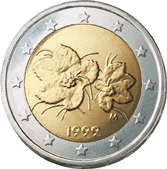Cloudberry
|
|
| Cloudberry | ||||||||||||||
|---|---|---|---|---|---|---|---|---|---|---|---|---|---|---|
| Missing image Rubus_chamaemorus.jpg Cloudberry foliage and fruit | ||||||||||||||
| Scientific classification | ||||||||||||||
|
The cloudberry is a species of slow-growing bramble, Rubus chamaemorus L.; producing tasty fruit. The botanical name derives from the Greek "chamai" (="dwarf") and "morus" (="mulberry"). Cloudberry is the name for both the plant and the fruit.
| Contents |
Description
The cloudberry plant grows to 10-25 cm high. Leaves alternate between having 5 and 7 soft, handlike lobes on straight, branchless stalks. After pollination, the white (sometimes reddish-tipped) flowers form raspberry-sized berries. Encapsulating between 5 and 25 berries, each fruit is initially pale red, ripening into an amber colour in autumn.
Distribution
Cloudberries occur naturally throughout the Northern Hemisphere from 78°N, south to about 55°N, and very scattered south to 44°N mainly in mountainous areas. In Europe, they grow mainly in the national forests of Scandinavia, the moorlands of Britain and Ireland, and in Russia and the Baltic states. Small populations are also found further south, as a botanical vestige of the Ice Age; it is found in Germany's Weser and Elbe valleys, where it is under legal protection. In North America, cloudberries grow wild in the forests of the thinly populated North shore region of Quebec, on the Magdalen Islands in the Gulf of Saint Lawrence, and throughout Newfoundland and Labrador.
It grows in bogs, marshes and wet meadows and requires sunny exposures in acidic ground (between 3.5 and 5 pH). The cloudberry can withstand cold temperatures down to well below -40°C, but is sensitive to salt and to dry conditions.
Propagation
Unlike most brambles, the cloudberry is not self-pollinating. Pollination requires a plant of the opposite sex. Wide distribution occurs due to the opening of capsules by birds and animals and the excretion of the indigestible seeds. Further distribution arises through its rhizomes; developing extensive berry patches.
Despite its modern demand as a delicacy exceeding supply (particularly in Norway) the cloudberry is principally a wild plant.
Since the middle of the 1990s, however, the cloudberry has formed part of the "Northberry" Research Project. The Norwegian government, in co-operation with Finnish, Swedish and Scottish counterparts, has vigorously pursued the aim of enabling commercial production of various wild berries (Norway imports 200 - 300 tonnes of cloudberries per year from Finland). Beginning in 2002, selected cultivars have been available to farmers, notably "Apolto" (male), "Fjellgull" (female) and "Fjordgull" (female). The cloudberry can be cultivated in arctic areas where few other crops are possible, for example along the northern coast of Norway.
Uses
The ripe fruits are golden-yellow, soft and juicy, and are rich in Vitamin C. When eaten fresh, cloudberries have a distinctive tart taste. They are often made into jams, juices, tarts or liqueurs. In Finland the berries are eaten with "Leipäjuusto" (a local hard cheese) and much sugar. In Sweden, they are also used as an ice cream topping. In Canada, cloudberries are used to flavour a special beer. Canadians also use them for jam, but not on the same large scale as Scandinavians.
Due to its high Vitamin C content, the berry is valued both by Nordic seafarers and by American Inuit as protection against scurvy. Its high benzoic acid content acts as an inbuilt natural preservative.
In ancient Scandinavian herbal medicine, the leaves of cloudberry were used as tea to cure urinary tract infections.
Cloudberry is used as a food plant by the larvae of some Lepidoptera species including Emperor Moth.
Other Names
Other names for the cloudberry include:
Canada: "plaquebiere", "chicoutai" (in Quebec), "bakeapple" (in Newfoundland)
Danish: "multebær"
Finnish: "lakka", "suomuurain", "hilla"
German: "Moltebeere", "Multebeere", "Multbeere", "Torfbeere"
Italian: "camemoro", "rovo artico", "lampone artico"
Norwegian: "Molter", "Multer"
Swedish: "hjortron", "multebär", "myrbär", "snåtterblomma", "solbär"
Other notes
The Finnish 2-Euro coin displays the cloudberry fruit and leaves.
There is also an indie rock band based in Linköping, Sweden called Cloudberry Jam.
External References
- The "Northberry" Research Project (http://www.uku.fi/northberry/mmpop.html)
- Picture from the free Swedish book edition "Project Runeberg" (http://www.lysator.liu.se/runeberg/nordflor/pics/311.jpg)
- Cloudberry Jam (http://www.cloudberryjam.se/) - indie-rock band
This text bases on a translation of de:Moltebeere in the German Wikipedia as of November 11, 2003.da:Multebær (Rubus chamaemorus) de:Moltebeere fr:Plaquebière fi:Lakka it:Camemoro sv:Hjortron
Categories: Rubus | Fruit

